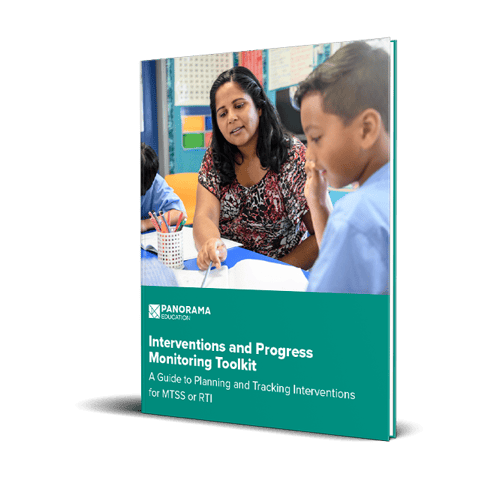Research shows that academic and behavior challenges are intertwined. When students have academic challenges, they are more likely to exhibit unwanted behaviors, and vice-versa. By incorporating behavior data into MTSS decision-making processes, districts can better meet the needs of all students and move the needle on positive behavior.
Download Panorama's Behavior Incident Report Templates
5 Ways to Incorporate Behavior Data Into Your District's MTSS
We know that data-based decision making is central to developing an MTSS framework. But it’s not always clear which data should be used—or even how to collect information in a meaningful way.
By collecting the right data, creating tiered intervention menus, and developing systems of student and school-wide progress monitoring, your school district can move the needle on student behavior and create an engaging and positive school climate.
Collect the Right Data to Develop Specific Interventions
Developing tiered inventions takes time and data. Because a goal of an MTSS framework is to equitably support all students, your school or district should ask:
- Which students need targeted support?
- What should we do to help those students?
- How will we know if what we’re doing is working?
In order to answer these questions with a data-driven approach, schools can use major and minor incident report forms and teacher reports. Consider collecting the Big 5 of behavior incident data—what, where, when, who, and how often:
- What behaviors are being reported most frequently?
- Where are these behaviors being reported?
- When are behavior incidents occurring?
- Who are the students, or groups of students, demonstrating these behaviors?
- How often are these behavior incidents occurring?
The Big 5 can help you see patterns and check hunches like, “It feels like a lot of class disruptions happen before fifth grade lunch.” Collecting the right data can also help you develop the right interventions for each student.
|
Data collection should be as easy as possible for teachers and other building staff. Make user-friendly forms or use purpose-built software with a friendly user interface, such as Panorama Behavior Logging & Analytics, to underpin your behavior incident report system. |
Create a Tiered Intervention Menu to Provide Behavior Support
An intervention and support menu, or a library of evidence-based interventions and supports, is a great way to align your school or district around specific strategies for supporting students. While the menu can be flexible, a standardized list can help staff members decide how to take action when they identify students in need. A shared list can ensure educators are trained on interventions and that each intervention can be quickly deployed.
Typically, schools and districts organize their menus or libraries by tier. Sample behavior strategies to support students within a tiered framework could include:
- Behavior-Specific Praise: A type of praise that acknowledges students’ appropriate behavior and provides them with specific details about the positive behavior they are engaging in.
- The Good Behavior Game: This classroom management strategy helps students learn teamwork. They receive positive reinforcement for promoting and following classroom rules, and they practice monitoring and managing their own behavior.
Tier 2:
- The Lunch Bunch: A small group-oriented behavioral intervention that provides students with ongoing opportunities to make connections with peers while working toward concrete behavioral goals.
- Check-In/Check-Out (CICO): A behavioral intervention that provides students with a mentor who facilitates daily check-ins and gives feedback on the students’ behavior and goals.
- Check and Connect: An intervention used with K-12 students who show warning signs of disengagement with school and who are at risk of dropping out.
Tier 3:
- Data-Based Individualization: Using functional behavior assessment to design individualized/intensive intervention plans.
|
Did you know? Districts that partner with Panorama have access to Playbook, Panorama’s professional learning library that connects educators with hundreds of evidence and research-based strategies. |
Ensure Educators Are Implementing Practices With Fidelity
Research shows that when schools implement Tier 1 PBIS with fidelity, students can be less likely to have discipline problems and have higher ratings on life skills and behavior measures.
You can take specific steps to ensure school-wide approaches and interventions are implemented with fidelity:
- Provide high-quality professional development on implementing a tiered framework and common interventions to ensure teachers, staff, and administrators feel confident in their ability to provide appropriate interventions and monitor student progress.
- Design your MTSS approach and choose evidence-based practices to fit your local needs. You can use tools such as the hexagon tool from NIRN to help explore if your framework and selected interventions meet your school’s needs.
- Ensure you set yourself up for success. Effective implementation requires a confluence of effective practices and enabling contexts.
- Monitor implementation fidelity of universal school-wide practices and targeted Tier 2 and Tier 3 interventions.
Develop a System For Screening and Progress Monitoring
Screening and progress monitoring are central to MTSS. By providing universal screening to all students at regular intervals, you can identify when school- and class-wide interventions are needed. Incident reports are important screeners within the PBIS framework, and can be used to identify students who may need more support and develop specific intervention plans.
Progress monitoring is the process of using data to understand how a student is doing once an intervention plan is underway. When done early and often, progress monitoring can ensure that you aren’t wasting time and resources on an intervention that isn’t working. Depending on the intervention, you may choose to progress monitor on a daily, weekly, biweekly, or monthly basis.
The Center on Multi-Tiered System of Supports suggest six steps for effective progress monitoring, including:
- Design progress monitoring process
- Select progress monitoring tools
- Train staff
- Develop student progress monitoring plans
- Collect progress monitoring data and monitor intervention fidelity
- Analyze progress monitoring data
|
Your school or district can use Panorama’s free Interventions and Progress Monitoring Toolkit to create an intervention menu, design student intervention plans, and progress monitor. |
Assess Student and School-Wide Progress
If you are a school or district leader who oversees MTSS on your campus, you may be most interested in analyzing the performance of interventions from a bird’s-eye view—such as the overall progress of students receiving interventions. This can help you allocate or redistribute resources to ensure that your system is meeting student needs equitably and at scale.
Here are a few metrics to get started assessing the overall health of your support system:
- What percent of students are receiving Tier 2 or Tier 3 interventions?
- What percent of intervention plans are up to date?
- Which intervention strategies are used most frequently and/or most successful?
- What percent of students met their goals or are on track to meet their goals?
Partnering With Panorama to Move the Needle on MTSS
It’s hard to make data-based decisions on your school district’s PBIS framework without access to student data. With Panorama Student Success, your school district can add in-depth behavior reporting next to academic, attendance, and life skills data. Administrators can get visibility into the what, where, when, who, and how often (The “Big 5”) of behavior incidents at the district, school, and student levels, and take action on the data with Tier 1 programs and individualized student supports to improve behavior.
Collect Actionable Behavior Data With Our Free Behavior Incident Report Templates





![What Is a Behavior Intervention Plan? [PDF Template]](https://www.panoramaed.com/hubfs/iStock-1994452964.jpg)
